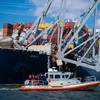US Ocean & Coastal Shipping Market Report
A decline in demand for freight transportation leads IBISWorld to update its market report on US Ocean & Coastal Transportation.
The transportation sector provides deep-sea, coastal, Great Lakes and St. Lawrence Seaway water transportation. The deep-sea shipping activity includes US flagged vessels and non-US flagged vessels. Marine transportation establishments using the facilities of the St. Lawrence Seaway Authority Commission are considered to use the Great Lakes water transportation system. This industry also includes deep-sea passenger transportation such as cruise ships.
The updated report indicates that an overall decline in demand for freight transportation caused nearly all operators to struggle during the recession. However, the overall economic revival will pave the way for industry growth, as demand for waterborne freight shipping, cruise travel and higher fuel prices stimulate revenue. Despite these positive factors, external competition will prove to be an imminent threat.
Excerpts from the report:
In the five years to 2012, revenue for the Ocean and Coastal Transportation industry is expected to decline at an annualized rate of 2.2% to $28.3 billion. According to IBISWorld analyst Lauren Setar, “The global shipping market struggled during the recession as consumers began to spend less, reducing the trade of goods around the world.” Cruise companies also felt the economic pinch, and many were forced to reduce prices to maintain capacity. Furthermore, fluctuations in the price of fuel have led firms to pass fuel surcharges onto clients, thereby contributing to revenue volatility. In 2009, falling fuel prices (leading to falling fuel surcharges) and declining demand contributed to a 17.0% reduction in revenue. However, the return to economic growth has caused demand to gain momentum. IBISWorld estimates industry revenue will increase 1.4% in 2012.
The Ocean and Coastal Transportation industry has a moderate level of concentration, with the four largest players estimated to account for about half of industry revenue in 2012. By contrast, the 2002 US Census reported that the industry's four largest firms had just above one-third of industry revenue, showing that concentration has increased moderately in the years since. As firms have grabbed more market share, some players have been forced out of the industry or acquired by other competitors. This has caused a period of consolidation in the five years to 2012, when the number of industry enterprises has declined an average of 1.8% annually.
About 46.2% of firms in this industry employ fewer than five people and 59.5% employ fewer than ten workers. The average number of employees per establishment has trended upwards over the past five years. This is due to an increasing number of workers at the industry's largest firms. These companies have increased their market dominance in the past five years, and their growth in employee numbers has matched this. Over the next five years, IBISWorld projects that industry market share will continue consolidating.
In the five years to 2017, waterborne freight shipping in the United States will pick up as the cogs in the broader economy start turning again. During that time, IBISWorld forecasts that industry revenue will continue its steady growth as the world economy slowly emerges from recession. Revenue growth will also be spurred on by rising demand for cruise vacations and increasing trade volume.
For more information click here.
















